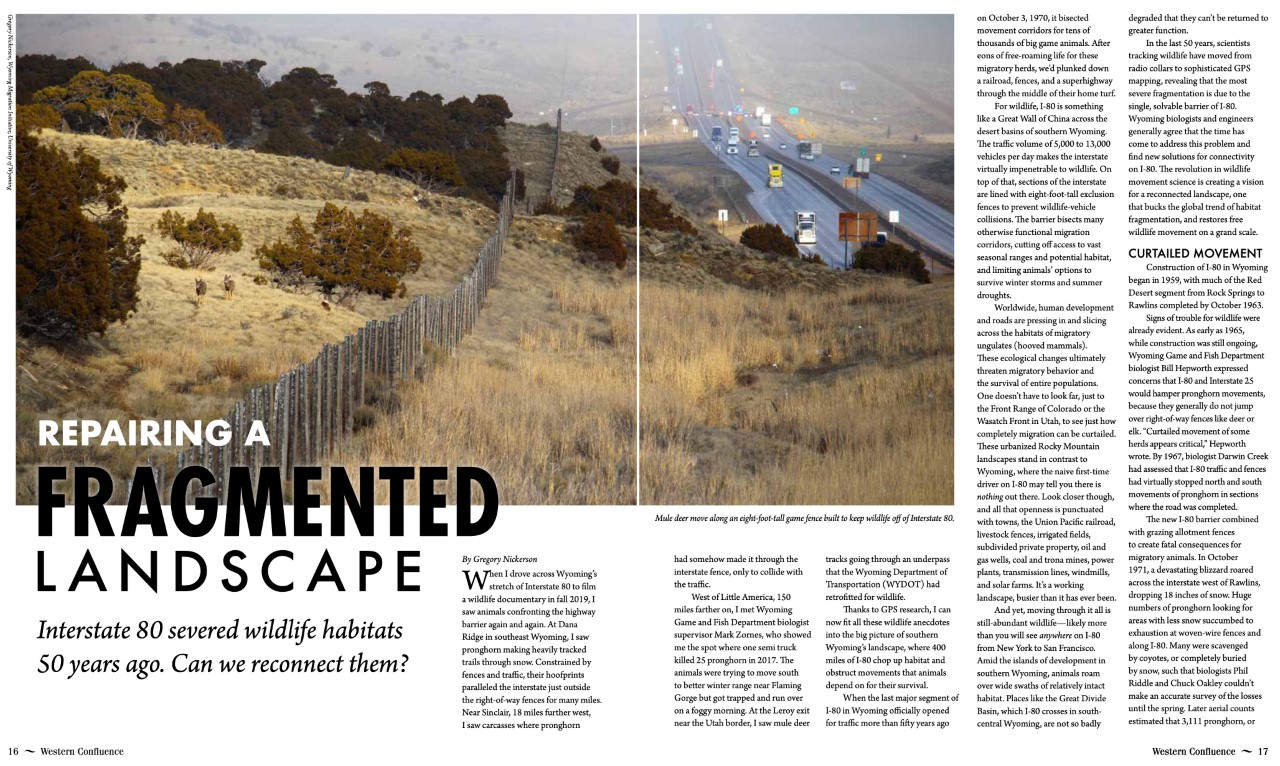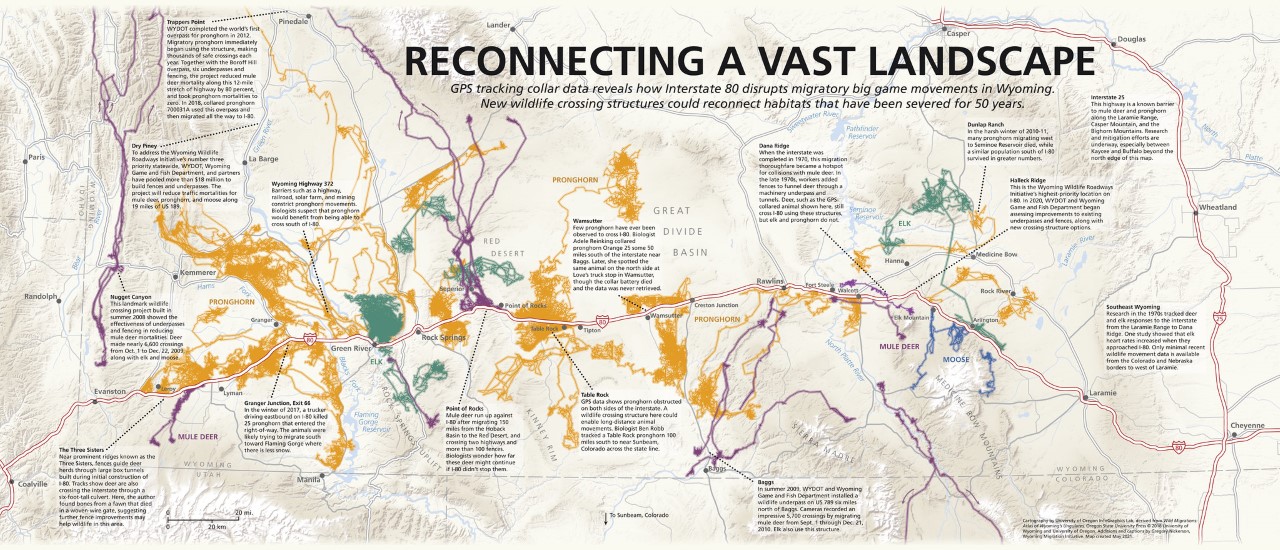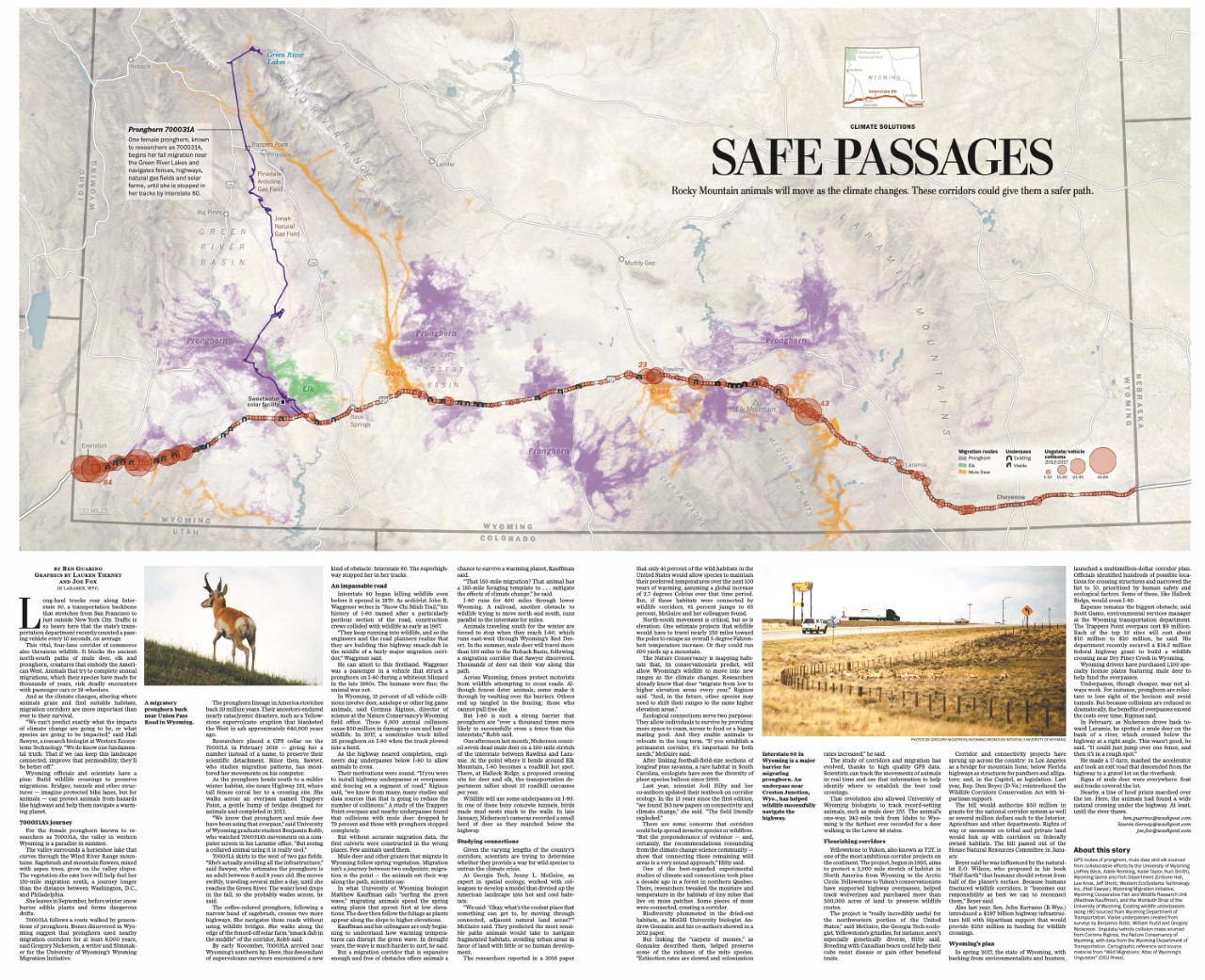Interstate-80 Wildlife Barrier Projects
Data collected by many researchers over decades has revealed that Interstate-80 is the single biggest barrier to big game animals in Wyoming — and perhaps the entire Northern Rockies.
Wyoming Game and Fish biologists recognized this barrier while I-80 was under construction more than fifty years ago. However, the full picture of how the interstate alters and obstructs wildlife movements has only emerged in recent years due to advances in GPS tracking collar technology.
Efforts to retrofit fences and underpasses for better wildlife connectivity are already being implemented across the state by WYDOT and Wyoming Game and Fish Department. Many of these projects focus on two-lane roads that have higher wildlife mortality and driver safety issues than I-80, yet no road severs more habitats than I-80.
Fixing the entirety of the I-80 wildlife problem would be more expensive and complex than smaller-scale local projects. Yet it is arguably one of the most significant large-landscape conservation opportunities in the American West.
Wider public knowledge of Interstate 80 wildlife research will help make migration connectivity a part of all future I-80 infrastructure projects in Wyoming.
OUTREACH

Western Confluence article and map
WMI writer and filmmaker Gregory Nickerson published a comprehensive review of 50 years of Interstate 80 wildlife research in Issue 11 of Western Confluence magazine, a publication of the Ruckelshaus Institute of the Haub School of Environment and Natural Resources at the University of Wyoming. The story was edited by Emilene Ostlind, text editor of Wild Migrations: Atlas of Wyoming’s Ungulates. Read the article here >
The article contains the most comprehensive map of wildlife movement data along the Interstate 80 produced to date. Explore and download the map here >

400 Miles to Cross Film
The 12-minute film, 400 Miles to Cross: The I-80 Wildlife Barrier is available on this website, as well as Facebook, YouTube, and www.muleyfanatic.org. It shows that Interstate 80 is an almost impenetrable obstacle to movement of pronghorn, mule deer and elk. The highway has severed or truncated migration corridors originating as much as 150 miles away. In 2019, WMI’s Gregory Nickerson and filmmaker Leon Schatz set out looking for answers to how the road affects big game herds, and interviewed many experts who have been on the front lines of this issue for decades. The film makes clear that Wyoming and other Western states have the science and the tools necessary to fix this problem.
Ben Robb pronghorn research film
Follow along with Wyoming Coop Unit graduate Ben Robb, who completed his MS thesis on pronghorn movements and potential wildlife crossing locations along Interstate 80.

Washington Post article
Science reporter Ben Guarino and cartographer Lauren Tierney published a story in March 2020 about Wyoming’s research on the effects of I-80 on wildlife movements. The interactive feature draws from many data sets collected by dozens of studies and researchers over more than a decade, and shows how Wyoming Department of Transportation and Wyoming Game and Fish Department are seeking solutions for better wildlife connectivity. Read the article here »
Research
Pronghorn and wildlife crossing thesis
Wyoming Coop Unit MS student and WMI graduate fellow Benjamin Robb completed his thesis in 2020, which explored pronghorn habitat usage on both sides of I-80. Part of his work focused on using camera traps to identify underpasses that could be retrofitted for better pronghorn passage. He also identified pronghorn habitat patches on either side of the interstate that could help site future crossing structures for better migration connectivity. Among other findings, Robb documented pronghorn migration corridors along the west side of Flaming Gorge Reservoir, and a pronghorn movement from Wamsutter, WY south into Colorado. Robb’s work built on previous researchers profiled in the Western Confluence article above.
Follow this link to find Ben Robb’s thesis: Pronghorn Migrations and barriers: Predicting Corridors Across Wyoming’s Interstate 80 to Restore Movement.
ADDITIONAL RESOURCES AND PAPERS
- Wyoming Wildlife and Roadways Initiative
- Trust Magazine article: Writer Jennifer Holland published a review of wildlife crossing projects and funding prospects around the West, which featured Wyoming’s own Trapper’s Point project. Her reporting coincided with the production of final scenes of the 400 Miles to Cross film. Read the story here.
- Peterson, C. Safe Passage: Investment in highway crossing structures for wildlife is paying off. Wyoming Wildlife. Dec. 2019.
Research papers:
- Reinking, A. K., K. T. Smith, K. L. Monteith, T. W. Mong, M. J. Read, and J. L. Beck. 2018. Intrinsic, environmental, and anthropogenic factors related to pronghorn summer mortality. Journal of Wildlife Management 82:608–617.
- Sawyer, H., Rodgers, P.A. and Hart, T. (2016), Pronghorn and mule deer use of underpasses and overpasses along U.S. Highway 191. Wildl. Soc. Bull., 40: 211-216.
- Taylor, K. L., J. L. Beck, and S. V. Huzurbazar. 2016. Factors influencing winter mortality risk for pronghorn exposed to wind energy development. Rangeland Ecology and Management 69:108–116.
- Melanie E F LaCava, Roderick B Gagne, Sierra M Love Stowell, Kyle D Gustafson, C Alex Buerkle, Lee Knox, Holly B Ernest, Pronghorn population genomics show connectivity in the core of their range, Journal of Mammalogy, 10.1093/jmammal/gyaa054, (2020).
